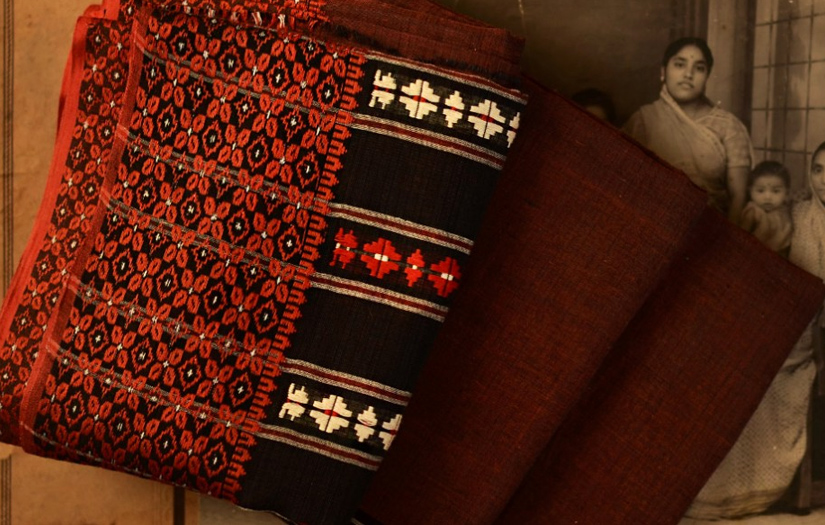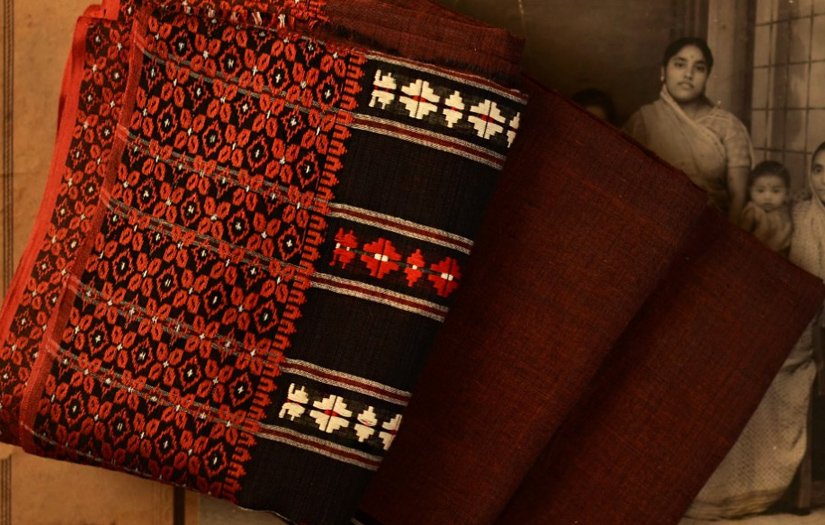
Begampur is a small and well-known village in Hooghly district, Chanditala II block in West Bengal. Located 30 kilometres from Kolkata, it is well connected by road and rail.
This village is primarily inhabited by people who weave handlooms, especially their Begumpuri Saree. Since the last decade, the number of handloom weavers has diminished from about 4000 to about 2000.
It was long-known that handloom weavers produced a type of sari known as ‘matapar’ saris, meaning simple borders without any ornamentation, woven with coarser cotton yarns (40s x 40s & 40s x 60s). Typically these cheaper varieties of saris feature coloured stripes and check patterns, as well as designs along the border.
Weavers have been taught designing, dyeing, and preparing processes like drum warping and sizing following the cluster intervention. Moreover, they specialize in dobby weaving and jacquard weaving with the aim of producing diversified products. New techniques and modifications taught to the weavers enabled them to produce new varieties of quality cotton sarees.
Bengal is known for its handwoven cotton sarees and is the center for fine cotton weaving, and these Begampuri cotton sarees are known for their loosely woven lightweight and translucent fabric, making them exceptionally comfortable to wear. Although the saree fabric is named after the city, the subtle madness look after wearing them is absolutely sophisticated, as they will last one to two days to weave. The more intricate designs may even take five to six days to weave.
Materials Used in Begumpuri Sarees
Begampuri sarees are usually woven with cotton yarns ranging from 40 to 100 counts. To keep the texture of sarees at par with Dhaniakhaligharana, steel reeds of 56s to 76s are commonly used. The number of picks per inch is almost equal to the number of ends per inch. In this way, a balanced texture can be obtained, which makes it more comfortable to wear.
Wooden Dobbies are widely used for extra warp designs and Jacquards are also in use at present.
Weaving Technique of a Begumpuri Saree
Begampuri sarees are woven with a serrated edge motif and contrasting borders in colours including red, black, purple, and orange. Utilizing cotton yarn that has been coloured, narrow to wider borders are woven with patterns featuring a variety of stripes and figured motifs. These wide borders, often referred to as “maathapaar” or “Beluaaripaar,” were frequently made of two colours, such as black and scarlet, and had a compact weave, which made them more durable.
In Begampur, hank yarn size is in use. Sage, arrowroot, rice, wheat, and parched rice (also known as “Khai”) are the principal starches used for size. The traditional method of street warping has been replaced with a sectional warping machine. On a frame loom or pit loom, a local wooden dobby with a capacity of up to 60 levers is typically used for weaving.
A Guide to Identifying Begumpuri Sarees:
- The body of the saree and the borders typically have contrast tones of colour.
- Even though it was initially originated from Dhanikhaligharana, one can recognise the designs and “chiur,” the designs formed by wooden pattayas and a few variants are woven with “khejurchuri.”
Fabric care for Begampuri cotton sarees
- For dry cleaning, the initial few washes should be used.
- Make sure to clean the saree with cold water before washing.
- Always wash sarees and other garments of dark and light colours separately.
- Use mild detergent (delicate mode wash cycle) when doing laundry at home.
- Never wring or squeeze the fabric.
- Dry these sarees in the shade once the wash cycle is finished because sunshine may cause the colors to fade.
- These sarees don’t need to be starched frequently.
- Do not bleach the saree’s fabric or soak it in water for an excessively lengthy time.
- To remove creases from fabric, iron it at a medium-low temperature.
- A warning that pure cotton saree fabric may shrink, but don’t be alarmed.
Our Most Selling Begumpuri Saree
Handwoven Begumpuri Cotton Saree with Tassel
Features of Biswa Bangla Begumpuri Sarees
- Authentic Begumpuri Saree, handwoven in Bengal
- Handloom Saree without Blouse Piece
- Care Instruction: Dry Clean Only
- Slight irregularity in Design and Colour is a unique characteristic of Handwoven Fabric or Textiles
- Colour and Texture of the product may slightly vary than that in the photograph.
This craft, which has been practiced for more than 250 years, has been handed down the generations. The weavers are claimed to collaborate with their families and work in such harmony that it resembles a business of some type. Less than half of the 5,000 weavers that existed in the previous decade have continued in their trade because the younger generation is gradually migrating to larger places in search of fixed-rate employment.
Studies reveal that there has been a substantial fall in the popularity and production of the product as a result of globalization, as well as the pay of the weavers. With new initiatives and development programmes, the government is undoubtedly making an attempt, and if things go as planned, this could undoubtedly be a success story for Indian handloom artistry.
Have a look at our best collection of Begumpuri Sarees!
Marketing for this company is being handled by a Digital Marketing Company in Kolkata.
